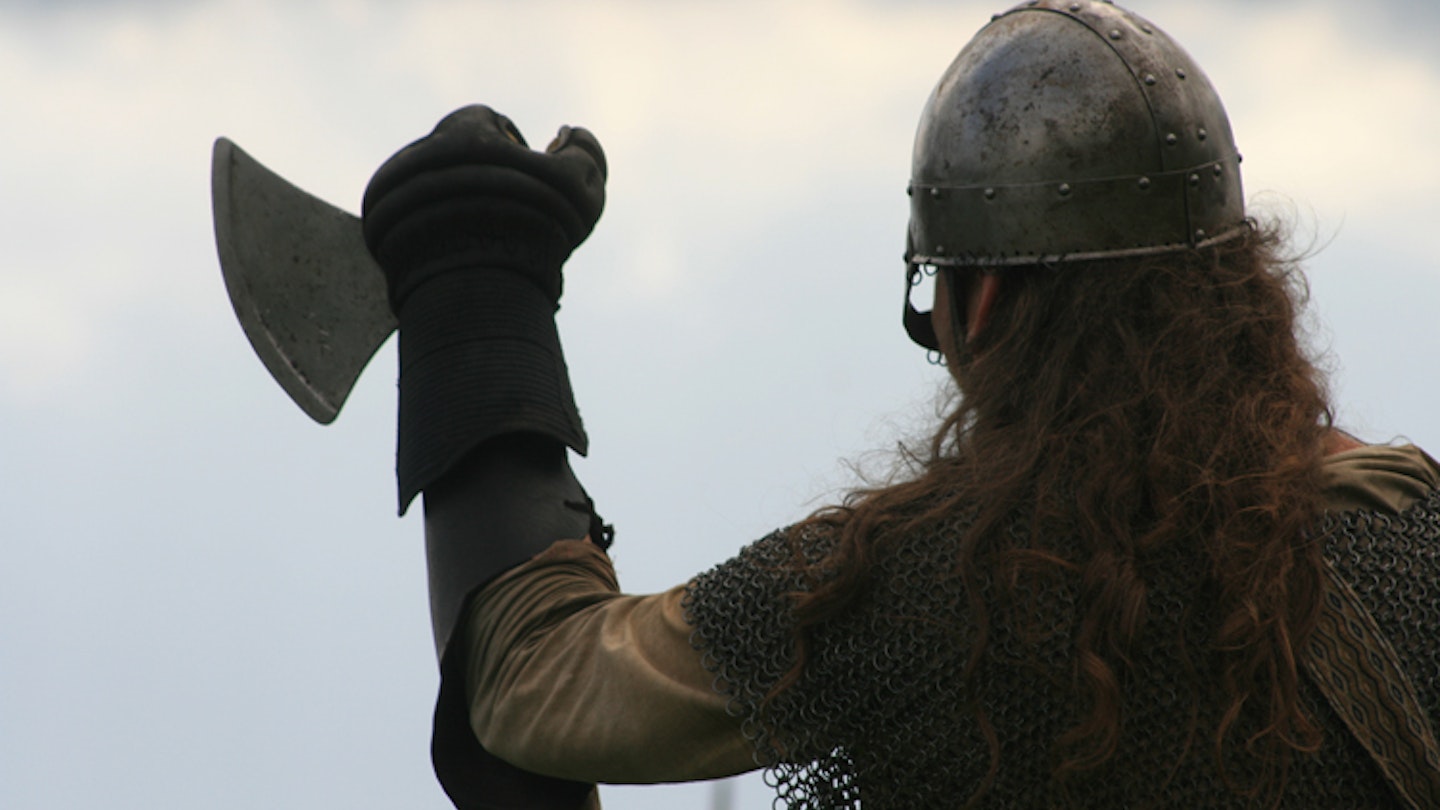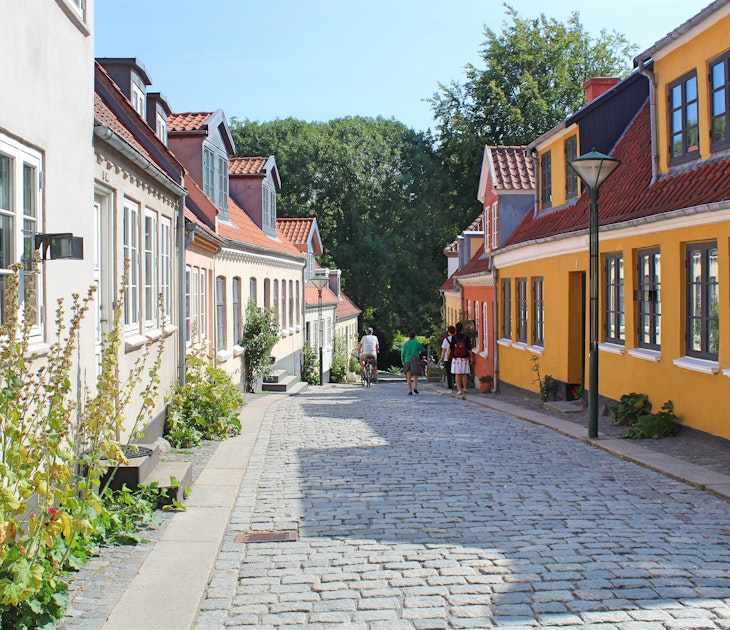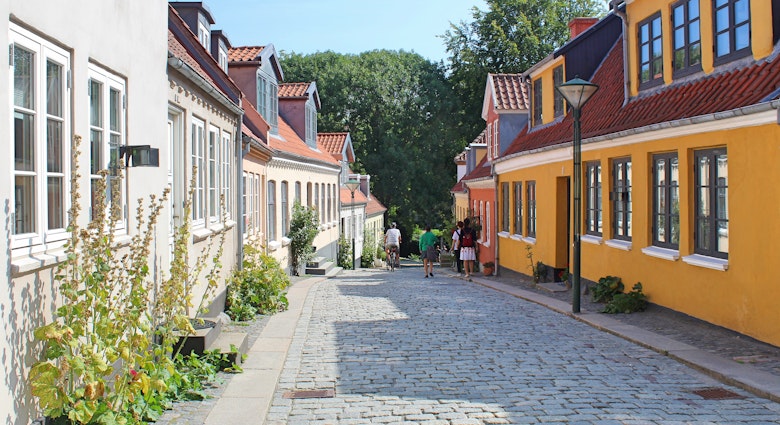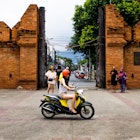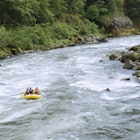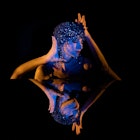Were Vikings mead-swilling and pillaging hooligans, or civilising craftspeople, poets and merchants? Your preconceptions around Vikings will likely be challenged in Denmark, where a series of burial sites, rune stones, settlements and museums brings this age to life. The Vikings' gods and beliefs, their stupendous feats of navigation, their customs, their longships, their intricate jewellery, carvings and sagas - it's all here. Just forget the horned helmets - they didn't wear them.
A more authentic Viking get-up. Image by Manuel Velasco/E+/Getty Images.
History in a nutshell
The Viking Age is the period from 793 to 1066, when Scandinavian seafarers from Denmark, Norway and Sweden ventured into Europe by sea and river for trade, raids and conquest.
The Vikings were known and feared throughout northern Europe, but battle and bloodlust is far from the whole story. These Norsemen (or Northmen, as they were known in Britain) were not just plunderers but successful traders, extraordinary mariners and insatiable explorers.
Viking sites in Denmark
The Viking era is celebrated and re-created at various sites around Denmark. Rest assured that Danish museums and historic sites are showcases of good design and interactivity for all audiences - from history buffs to kids normally bored by history. A rich resource for tapping into Viking Denmark is VisitDenmark (visitdenmark.com).
National Museum, Copenhagen
Any course in 'Danish History 101' could begin at the National Museum in the capital. The museum has first dibs on virtually every antiquity found on Danish soil, with a resulting collection that includes Viking weaponry, unearthed loot (like silver hoards and gold jewellery) and impressive rune stones.
Viking Ship Museum, Roskilde
Just 25 minutes by train from Copenhagen is Roskilde. The town has plenty of drawcards (including one of Europe's best outdoor music festivals and a cathedral housing dozens of royal crypts), but for anyone fascinated by Viking voyages, it's the mother lode: five Viking ships were excavated from the bottom of Roskilde Fjord in 1962 and are displayed at the superb Viking Ship Museum.
Viking longships on display at the Viking Ship Museum in Roskilde. Image by Martin Moos/Lonely Planet Images/Getty Images.
Around the mid-11th century, these ships were filled with stones and scuttled to block the entrance to the fjord to protect Roskilde, which was the capital of Denmark at that time. What’s remarkable — beyond the feat of resurrecting the ships and piecing them together — is the range. The collection includes an ocean-going trading vessel, a 30m warship for international raiding, a coastal trader, a 17m warship probably used around the Baltic, and a fishing boat. Scientists have been able to decipher further secrets: one ship was made in Norway while another came from Dublin.
Survivors of raids described the Vikings' sleek square-rigged vessels as 'dragons flying in the air' and the raiders as 'terrifying heathens'. The museum incorporates waterfront workshops where replicas of ships are built using Viking-era techniques and tools. If you've always harboured an urge to leap aboard a longboat for a spot of light pillaging, join one of the museum's hour-long boat trips (from May to September). Replica Viking boats are propelled across the water by you and the rest of your shipmates. And when too much Viking experience is never enough, Restaurant Snekken has collaborated with the museum to put together a 'New Nordic Viking' menu that uses ingredients from the era: lots of fish (salted, smoked, dried), meats, berries, malt bread, and yes, of course, mead!
Ladbyskibet, Funen
The island of Funen is best known as the birthplace of one Hans Christian Andersen. In its northeastern reaches is a fascinating Viking Age ship grave, known as Ladbyskibet (the Ladby Ship, named after the nearby village).
Around the year 925, a Viking chieftain was laid to rest in a splendid 21.5m-long warship, surrounded by weapons, jewellery and other fine possessions. The wooden planks from the boat decayed long ago, leaving the imprint of the hull moulded into the earth, along with iron nails, an anchor, and the grinning skulls of sacrificed dogs and horses.
The site of the find, under a grassy mound, gives an eerie sense of time and place. The accompanying museum does a great job recounting what is known of the story; in the grounds, shipbuilders are recreating the ship itself.
Jutland sites
Viking burial ground, Lindholm Hoje, Aalborg. Image by Stuart Black/Robert Harding World Imagery/Getty Images.
On the large Danish peninsula that shares a border with Germany, there are a number of sites worth exploring: a circular fortress (nordmus.dk) constructed in the 10th century in Hobro; rune stones that tell a fascinating royal story in Unesco-recognised Jelling; and an atmospheric Viking burial ground north of Aalborg.
If you enjoy lifelike visual effects with your history lesson, consider timing your holiday with the Viking Moot (moesmus.dk), held in Aarhus in late July. The 'moot' is a meet, where the Viking era springs to life. Costumed folks? Check (in fact, 800 of them from around the world). Craftsmanship and authentic food? Oh yeah. Warrior and cavalry displays? Oh yes!
Viking camping re-enactment at Aarhus. Image by John Elk/Lonely Planet Images/Getty Images.
Ribe's history
The jewel in Jutland's Viking crown is Ribe, the country's oldest town which was founded around 700 as a Viking marketplace. This is historic Denmark at its most photogenic, all cobblestones and higgledy-piggledy houses - so pretty, it was recently voted 'Europe's Best Big-Time Small Destination' (hotel.info).
The pretty old town of Ribe. Image by Stuart Black/Robert Harding World Imagery/Getty Images.
Ribe was a key post of the Viking era, and here you can get a double-dose of Norse living: Museet Ribes Vikinger (ribesvikinger.dk) is an informative museum that presents Ribe's Viking and medieval history with more loot, craftworks, excellent explanations and a model of the town in 800. But go on, admit it: you're really here to embrace your inner Viking at Ribe VikingeCenter.
The VikingeCenter is a hands-on experience. Kicking off the season in May with a Viking market, the 'living museum' attempts to recreate a slice of life in Viking-era Ribe using various reconstructions, including a longhouse and an assembly hall. The staff, dressed in period clothing, bake bread over open fires, demonstrate archery and Viking-era crafts such as pottery and leatherwork, and offer falconry shows and 'warrior training' for kids complete with swords and shields (but no bloodletting).
